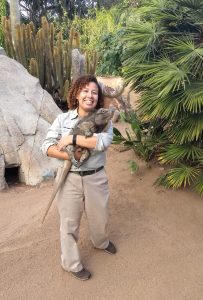Zoo InternQuest is a seven-week career exploration program for San Diego County high school juniors and seniors. Students have the unique opportunity to meet professionals working for the San Diego Zoo, Safari Park, and Institute for Conservation Research, learn about their jobs, and then blog about their experience online. Follow their adventure here on the Zoo’s website!
 Today we met Rachael Walton, Senior Reptile Keeper at the San Diego Zoo. Her job is to feed and care for the Zoo’s reptiles, from snakes to turtles to monitor lizards. Occasionally, she and her team train certain animals. Galapagos turtles and caiman lizards, for example, can be trained to come for food, and alligators can even be taught the meaning of “water”.
Today we met Rachael Walton, Senior Reptile Keeper at the San Diego Zoo. Her job is to feed and care for the Zoo’s reptiles, from snakes to turtles to monitor lizards. Occasionally, she and her team train certain animals. Galapagos turtles and caiman lizards, for example, can be trained to come for food, and alligators can even be taught the meaning of “water”.
Ms. Walton is a lifelong reptile lover, and when she was thirteen years old, she would show up to school every day wearing overalls so that she could fit her ball python, Hercules, in her front pocket. Her teachers were nice enough to let her carry Hercules around at school all day. I’m sure that if they could see Ms. Walton at work nowadays, they would show no surprise.
In high school, Ms. Walton worked as a vet tech in an emergency and critical care local vet clinic, and spent her summers at camp at the San Diego Zoo. She started her higher education with a bachelor’s degree in biology from San Diego State. During this time, she interned at the natural history museum in San Diego, which gave her hands-on experience with reptiles, field experience, and practice identifying types of venom. Ms. Walton also participated in a niche partitioning internship focused around agkistrodons such as copperheads and cottonmouths. These are North American snakes related to rattlesnakes, but without rattles.
It is important that reptile keepers are familiar with the first aid procedures involving reptile venom, as there is a specific antivenom and procedure for each venomous reptile. Some antivenoms are relatively rare, so the San Diego Zoo is one of the only places able to house certain species. The Zoo currently houses two baby king cobras that were confiscated in an illegal border smuggling effort, as they are one of the only facilities that has the right antivenom.
However, this training is not a problem for Ms. Walton, as she loves her job and wouldn’t want to be doing anything else. Her job as a reptile keeper not only consists of feeding and cleaning the enclosures of the animals, it also includes public education, talks with students, and enrichment for the animals. Ms. Walton says that her favorite part of her job is the pride she feels when baby reptiles that she has helped to breed are hatched.
While she doesn’t have a favorite reptile, Ms. Walton says that she could see herself working with rattlesnakes for the rest of her life because of how diverse and interesting they are. However, she enjoys cuddling with the reptiles, and because rattlesnakes are not good for cuddling, she likes to cuddle with the turtles and lizards.
You can protect your local reptile species by watching your step for lizards and snakes when you are out hiking or mountain biking, and avoiding leaving pollutants and trash in waterways where turtles live. Snakes in particular are crucial to local ecosystems, balancing the populations of rodents, lizards, and small birds. Though snakes may have a reputation as a danger to humans, they are not looking to get in your way and are much more likely to slither away from you than bite you if you watch your step.
Sage, Careers Team
Week Five, Fall Session 2017

